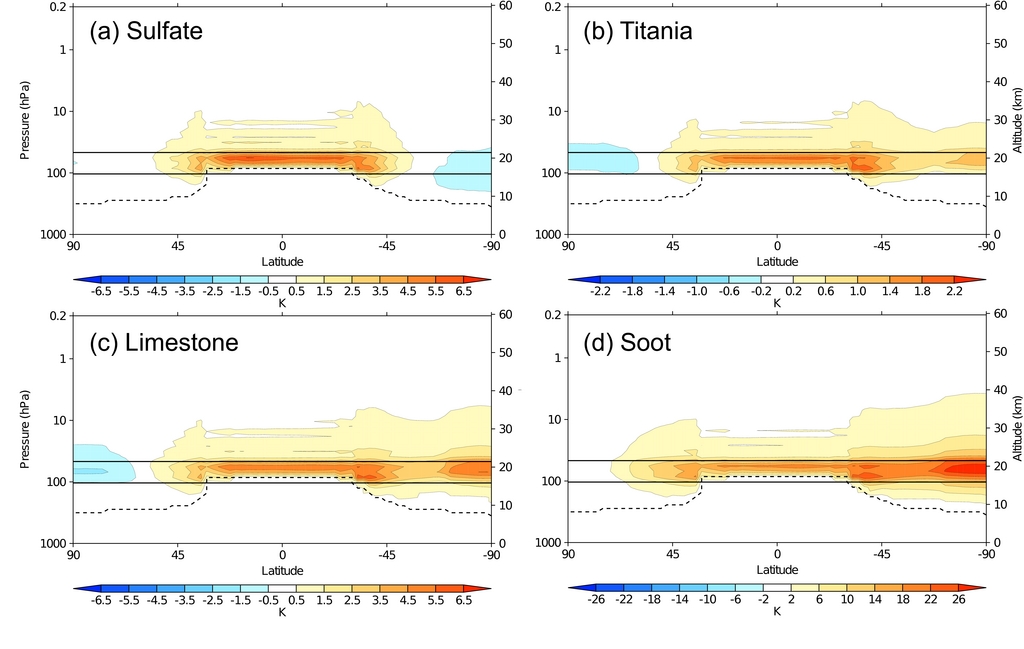Angus Ferraro: PhD research
Atmospheric responses to geoengineering in the stratosphere
My work is featured in the Walker Institute's 2012 research highlights brochure [pdf].

The stratospheric temperature response in the December-January-February season to a four different aerosol types. The amount of each aerosol nearly balances the radiative forcing from a doubling of atmospheric carbon dioxide concentration. Ferraro et al. (2011).
My work involves modelling the radiative-dynamical effects of a enhanced layer of sulphate aerosol in the lower stratosphere. There is a naturally-occurring layer of sulphate in the stratosphere, which has a cooling effect on the planet by decreasing its albedo. This cooling is greatly enhanced when the input of sulphur dioxide and other sulphur-containing compounds is increased due to volcanic eruption. Geoengineering schemes seek to reduce the warming effect of anthropogenic greenhouse gases. In this case, it is proposed that a volcanically-enhanced stratospheric sulphate layer can be permanently maintained through artifical injection of sulphur-containing compounds. Such geoengineering proposals have come to the forefront in recent years due to the failure of the world's governments to act meaningfully on decreasing greenhouse gas emissions.
The idea of artificially enhancing the stratospheric sulphate layer has many possible drawbacks. Some are very complex and difficult to investigate. For example, the climate achieved in a geoengineering world would only approximate the target climate. A target global-mean surface temperature might be achieved, but there would be local differences, so regional climate could be very different. Geoengineering through stratospheric sulphate injection would also do nothing to halt ocean acidification, and would increase ozone depletion since aerosols act as surfaces for chemical reactions. There are also many difficult questions of whether it is ethical to deliberately modify the climate, practical considerations of monetary cost, and how such a scheme would be governed.
There is a gap in the rapidly-growing literature on stratospheric geoengineering. Little consideration has been given to the dynamical impacts on the stratosphere of an enhanced aerosol layer. The aerosol layer would locally heat the stratosphere, and this perturbation may have significant impacts on stratospheric circulation. It may impact stratospheric variability by increasing the strength and stability of the polar vortex, or the strength of transport in the Brewer-Dobson circulation. Ozone depletion would reduce stratospheric heating. This could possibly act as a feedback on the system should the dynamical response to the heating anomaly impact ozone concentrations. Finally, such perturbations to the stratosphere will be communicated downward to the troposphere, so it is important to understand how this happens and what the impact might be.
My PhD in a nutshell
What I do using the 1000 most common words in the English language (from the Up-Goer Five text editor):
We make the air and the ground warmer by burning stuff which goes into the air. This stuff ('greenhouse gases') stops the air cooling a bit. It also changes winds and rain. Making the air warmer and changing winds causes problems because we are used to things being as they are. There are things to do to stop warming but we are not good at doing them. A new idea to stop warming is to put other stuff ('aerosols') high in the sky. It might make it less warm but not in all places. Also, the winds and rain might still change and so even if we put the other stuff in the sky we still have to deal with changes. This is a problem. I want to know how the changes from burning stuff are different from the changes we get when we put the other stuff in the air to stop the warming. I also want to know whether different types of stuff ('aerosols' which also stop warming) change the winds and rain less. This will help us decide if we want to put other stuff up there to stop warming.